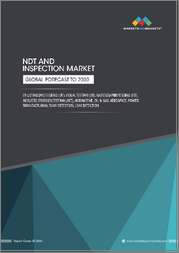
|
시장보고서
상품코드
1804802
고정형 NDT 및 검사 시스템 자동화 시장 : 유형, 구성요소, 기술, 용도, 최종사용자별 - 세계 예측(2025-2030년)Automated Stationary NDT & Inspection Systems Market by Type, Component, Technology, Application, End User - Global Forecast 2025-2030 |
||||||
고정형 NDT 및 검사 시스템 자동화 시장은 2024년에는 6억 653만 달러로 평가되었으며, 2025년에는 6억 5,354만 달러, CAGR 7.89%로 성장하여 2030년에는 9억 5,707만 달러에 달할 것으로 예측됩니다.
| 주요 시장 통계 | |
|---|---|
| 기준 연도 2024년 | 6억 653만 달러 |
| 추정 연도 2025년 | 6억 5,354만 달러 |
| 예측 연도 2030년 | 9억 5,707만 달러 |
| CAGR(%) | 7.89% |
최첨단 기술과 전략적 산업 적용으로 고정형 비파괴 검사 자동화 시스템에 혁명을 일으켰습니다.
자동 고정형 비파괴 검사 시스템은 안전, 무결성 및 규정 준수를 유지하기 위한 기본 기둥으로 중요성이 높은 산업 분야에서 각광받고 있습니다. 항공우주 부품 검증에서 중요한 석유 및 가스 인프라 평가에 이르기까지, 이러한 고정형 솔루션은 탁월한 반복성과 정확성을 제공합니다. 엄격한 규제 프레임워크와 함께 세계 생산 수요가 계속 확대됨에 따라 제조업체와 운영자는 워크플로우의 모든 단계에서 강력한 품질 보증 프로토콜을 통합해야 합니다.
인더스트리 4.0과 첨단 로봇 기술을 도입하여 고정형 비파괴 검사 및 검사 업무의 효율을 획기적으로 향상시켰습니다.
고정형 NDT 및 검사 산업 환경은 인더스트리 4.0의 원칙과 최첨단 자동화 기능의 통합으로 인해 큰 변화의 시기를 맞이하고 있습니다. 기존의 고정형 스캐닝 플랫폼은 머신러닝 알고리즘을 활용하여 검사 파라미터를 동적으로 조정하고, 부품의 형상이나 표면 상태가 시간에 따라 변하더라도 최적의 결함 검출을 가능하게 하는 지능형 시스템으로 진화하고 있습니다.
2025년 미국 관세 조정이 고정형 NDT 시스템의 공급망 및 비용 구조에 미치는 누적 효과 평가
미국이 2025년 새로운 관세 체계를 도입함에 따라 고정형 비파괴 검사 장비 공급망 이해관계자들에게 중요한 고려사항이 도입되었습니다. 특수 센서, 고정밀 모터, 주요 전자기기 등 주요 부품에 대한 관세 인상으로 인해 제조업체들은 비용에 미치는 영향을 완화하고 납기를 유지하기 위해 조달 전략을 재검토하게 되었습니다.
시스템 유형, 구성요소 계층, 고급 테스트 기술, 용도, 최종사용자 산업 전반에 걸쳐 중요한 세분화 관점을 밝힙니다.
다양한 검사 시나리오에 맞게 고정형 NDT 솔루션을 맞춤화하기 위해서는 세분화 차원을 포괄적으로 이해하는 것이 필수적입니다. 시스템 유형별로 평가하면, 컨베이어 구동 검사 라인은 고속 인라인 품질 검사에 최적화되어 있으며, 갠트리 시스템은 대형 구조 부품에 높은 유연성을 제공합니다. 포털형은 복잡한 형상에 적합한 다면 스캔 기능을 제공하며, 턴테이블 플랫폼은 원통형 부품에 이상적인 360도 전체 회전을 가능하게 합니다.
세계 지역 역학은 아메리카, 유럽, 중동 및 아프리카, 아시아태평양 시장에서 고정형 자동 비파괴 검사 도입 추세를 형성할 것입니다.
고정형 자동 비파괴 검사 시스템의 보급과 진화는 지역에 따라 크게 다릅니다. 아메리카에서는 미국의 항공우주 허브와 멕시코의 정밀 자동차 제조가 수요를 주도하고 있으며, 빠른 도입과 엄격한 FAA 및 EPA 표준 준수에 중점을 두고 있습니다. 캘리포니아와 온타리오의 혁신 센터는 북미 생산 라인에 AI 기반 분석을 통합하는 자율 검사 셀을 개척하고 있습니다.
고정형 비파괴 검사 장비 및 서비스의 미래를 앞당기는 시장을 선도하는 혁신가 및 전략적 제휴 프로파일 링
고정형 NDT 및 검사 분야의 선도적인 공급업체는 기술력, 전략적 파트너십, 종합적인 서비스 포트폴리오를 통해 두각을 나타내고 있습니다. 이 혁신적인 대기업은 제어 및 데이터 분석 소프트웨어에 인공지능 프레임워크를 통합하여 자율적인 결함 인식 및 예지보전 자문을 가능하게 하는 연구개발에 많은 투자를 하고 있습니다.
NDT 워크플로우의 업무 효율성과 품질 관리를 강화하기 위한 적극적인 전략과 기술 투자 실시
업계 리더들은 지속적인 성능 향상을 위해 새로운 기술과 운영 모범 사례를 활용하는 사전 예방적 전략을 채택해야 합니다. 검사 설비의 디지털 트윈 모델링에 우선적으로 투자함으로써 시운전 시간을 크게 단축하고, 물리적 배치 전에 커버리지를 검증할 수 있어 생산 라인 중단을 최소화할 수 있습니다. 동시에 데이터 분석 프레임워크에 머신러닝 알고리즘을 통합하여 수작업 개입 없이도 지속적인 교정 개선과 이상 징후를 감지할 수 있습니다.
1차 조사, 데이터 삼각측량, 투명성 높은 분석 프레임워크별 견고한 조사 방법을 통한 심층적인 시장 인사이트 제공
이러한 인사이트를 뒷받침하는 조사 방법론의 프레임워크는 1차 조사와 2차 조사를 엄격하게 결합하여 포괄적이고 편견 없는 분석을 실현합니다. 1차 조사에서는 주요 산업 분야의 검사 장비 제조업체, 부품 공급업체, 시스템 통합업체, 최종사용자 기업의 고위 경영진을 대상으로 심층 인터뷰를 진행했습니다. 이러한 대화를 통해 기술 채택 촉진요인, 비용 압박, 전략적 우선순위에 대한 생생한 관점을 얻을 수 있었습니다.
고정형 비파괴 검사 및 검사 기술 도입을 위한 변화의 길을 밝히기 위한 핵심 지식 통합
자동화, 첨단 센서 기술, 데이터 기반 분석의 융합은 고정형 비파괴 검사 및 검사 생태계를 재구성하고 있습니다. 기업이 진화하는 규제 환경, 복잡한 공급망 및 품질에 대한 요구사항에 대응하기 위해서는 통합된 지능형 검사 솔루션의 도입이 필수적입니다. 모듈형 아키텍처, 디지털 트윈, 예지보전 프레임워크로의 전략적 전환은 정기적인 품질 점검에서 지속적인 보증 모델로의 전환을 명확히 보여줍니다.
목차
제1장 서문
제2장 조사 방법
제3장 주요 요약
제4장 시장 개요
제5장 시장 역학
제6장 시장 인사이트
- Porter's Five Forces 분석
- PESTEL 분석
제7장 미국 관세의 누적 영향 2025
제8장 고정형 NDT 및 검사 시스템 자동화 시장 : 유형별
- 컨베이어 시스템
- 갠트리 시스템
- 포털 시스템
- 턴테이블 시스템
제9장 고정형 NDT 및 검사 시스템 자동화 시장 : 구성요소별
- 하드웨어
- 전원
- 프로브
- 스캐너
- 센서
- 트랜스듀서
- 서비스
- 교정
- 유지보수
- 트레이닝
- 소프트웨어
- 제어 소프트웨어
- 데이터 분석 소프트웨어
- 검사 소프트웨어
제10장 고정형 NDT 및 검사 시스템 자동화 시장 : 기술별
- 와전류 검사
- 기존 와전류
- 멀티 주파수 와전류
- 펄스 와전류
- 레이저 테스트
- 레이저 형상 측정
- 레이저 시어로그래피
- 자성 입자 검사
- 방사선 검사
- 컴퓨터 단층촬영
- 감마선 검사
- X선 검사
- 초음파 검사
- 접촉 테스트
- 위상 배열
- 비행 시간 회절
- 수침시험
제11장 고정형 NDT 및 검사 시스템 자동화 시장 : 용도별
- 코팅 검사
- 부식 검사
- 누출 검출
- 재료 시험
- 구조 검사
- 용접 검사
제12장 고정형 NDT 및 검사 시스템 자동화 시장 : 최종사용자별
- 항공우주 및 방위
- 자동차
- 건설·인프라
- 헬스케어
- 석유 및 가스
- 발전
제13장 아메리카의 고정형 NDT 및 검사 시스템 자동화 시장
- 미국
- 캐나다
- 멕시코
- 브라질
- 아르헨티나
제14장 유럽, 중동 및 아프리카의 고정형 NDT 및 검사 시스템 자동화 시장
- 영국
- 독일
- 프랑스
- 러시아
- 이탈리아
- 스페인
- 아랍에미리트
- 사우디아라비아
- 남아프리카공화국
- 덴마크
- 네덜란드
- 카타르
- 핀란드
- 스웨덴
- 나이지리아
- 이집트
- 튀르키예
- 이스라엘
- 노르웨이
- 폴란드
- 스위스
제15장 아시아태평양의 고정형 NDT 및 검사 시스템 자동화 시장
- 중국
- 인도
- 일본
- 호주
- 한국
- 인도네시아
- 태국
- 필리핀
- 말레이시아
- 싱가포르
- 베트남
- 대만
제16장 경쟁 구도
- 시장 점유율 분석, 2024
- FPNV 포지셔닝 매트릭스, 2024
- 경쟁 분석
- Blue Star Engineering & Electronics Ltd.
- Eddyfi Technologies
- Controle Mesure Systems SAS
- Evident Scientific Corporation
- FOERSTER Holding GmbH
- Innerspec Technologies, Inc.
- Karl Deutsch GmbH
- Magnetic Analysis Corporation
- MME Group
- Nordinkraft AG
- OKOndt Group
- Phoenix Inspection Systems Ltd.
- Rohmann GmbH
- ScanMaster International Ltd.
- Shantou Institute of Ultrasonic Instruments Co., Ltd.
- Vidisco Ltd.
- Viscom AG
- Waygate Technologies
- X-RIS
제17장 리서치 AI
제18장 리서치 통계
제19장 리서치 컨택트
제20장 리서치 기사
제21장 부록
KSM 25.09.11The Automated Stationary NDT & Inspection Systems Market was valued at USD 606.53 million in 2024 and is projected to grow to USD 653.54 million in 2025, with a CAGR of 7.89%, reaching USD 957.07 million by 2030.
| KEY MARKET STATISTICS | |
|---|---|
| Base Year [2024] | USD 606.53 million |
| Estimated Year [2025] | USD 653.54 million |
| Forecast Year [2030] | USD 957.07 million |
| CAGR (%) | 7.89% |
Revolutionizing Automated Stationary NDT & Inspection Systems With Cutting-Edge Technologies and Strategic Industry Adaptations
Automated stationary non-destructive testing and inspection systems have emerged as foundational pillars in maintaining safety, integrity, and compliance across high-stakes industries. From aerospace component verification to critical oil and gas infrastructure assessment, these fixed-format solutions deliver unparalleled repeatability and precision. As global production demands continue to escalate in tandem with stringent regulatory frameworks, manufacturers and operators must integrate robust quality assurance protocols at every stage of their workflow.
The pursuit of zero-defect outcomes has intensified the adoption of automation within stationary inspection. By removing manual variability and enhancing throughput, automated platforms enable inspection routines that were once too time-consuming or cost-prohibitive. Furthermore, advances in sensor fidelity and control software have expanded the detection envelope, allowing for earlier identification of microstructural flaws and subsurface anomalies without compromising cycle times.
Looking ahead, the convergence of real-time data analytics, advanced robotics, and adaptive control algorithms will reshape conventional stationary NDT deployments. Rather than treating inspections as isolated events, organizations are embedding continuous monitoring loops that feed intelligence into predictive maintenance strategies. This shift underscores a broader commitment to operational excellence, where quality assurance and process optimization drive sustainable competitive advantage.
Embracing Industry 4.0 and Advanced Robotics to Drive Unprecedented Efficiency in Stationary NDT and Inspection Operations
The landscape of stationary NDT and inspection is undergoing a profound transformation driven by the integration of Industry 4.0 principles and cutting-edge automation capabilities. Traditional fixed scanning platforms are now evolving into intelligent systems that leverage machine learning algorithms to adapt inspection parameters dynamically, ensuring optimal defect detection even as part geometries and surface conditions vary over time.
In parallel, robotics integration has accelerated throughput and safety. Automated gantry and portal systems equipped with collaborative robots can maneuver probes and sensors with sub-millimeter accuracy, reducing human intervention and enabling inspections in hazardous environments. This synergy between robotics and advanced control software fosters a more agile inspection paradigm, where the system itself recommends calibration adjustments or scanning patterns based on live feedback.
Moreover, digital twin simulations are being used to model inspection scenarios before they occur on the factory floor, minimizing setup times and validating inspection coverage. Remote monitoring and cloud-based analytics further enhance decision-making, providing centralized visibility across multiple facilities. As these transformative shifts converge, stationary NDT platforms are poised to deliver unprecedented levels of reliability, speed, and actionable insights across complex manufacturing ecosystems.
Assessing the Cumulative Effects of 2025 United States Tariff Adjustments on Supply Chains and Cost Structures for Stationary NDT Systems
The implementation of new tariff structures by the United States in 2025 has introduced significant considerations for stakeholders in the stationary NDT equipment supply chain. Increased duties on key components, including specialized sensors, high-precision motors, and critical electronics, have led manufacturers to reassess sourcing strategies to mitigate cost impacts and maintain delivery schedules.
Some suppliers have responded by onshoring production of high-value assemblies, thereby reducing exposure to cross-border levies. This adjustment has fostered closer collaboration between equipment integrators and local component fabricators, expediting lead times for customized probe designs and control units. However, the shift in cost structures has also encouraged research into alternative materials and modular architectures that can achieve equivalent performance at lower duty classifications.
Despite these challenges, many system operators have leveraged long-term service contracts and predictive maintenance frameworks to amortize equipment investments more effectively. By extending the operational lifetime of critical assets through condition-based monitoring and calibration, firms have offset incremental tariffs with productivity gains and reduced unplanned downtime. As the landscape continues to stabilize, the lessons learned from 2025 tariff realignments will shape resilient procurement and operational models for stationary NDT deployments.
Unveiling Critical Segmentation Perspectives Across System Type, Component Hierarchy, Advanced Testing Technologies, Applications, and End-User Verticals
A comprehensive understanding of segmentation dimensions is essential to tailor stationary NDT solutions for diverse inspection scenarios. When evaluated by system type, conveyor-driven inspection lines are optimized for high-speed in-line quality checks, while gantry systems provide greater flexibility for large-scale structural components. Portal configurations deliver multiplanar scanning capabilities suitable for complex geometries, and turntable platforms enable full 360-degree rotation ideal for cylindrical parts.
Component segmentation further reveals opportunities to enhance performance and service offerings. Hardware investments such as advanced probes and multi-sensor arrays improve flaw visibility across critical thicknesses, whereas integrated software suites facilitate real-time control and data interpretation. Service modules encompassing maintenance, calibration, and operator training ensure sustained system reliability and operator proficiency, with specialized data analysis tools transforming raw inspection signals into actionable diagnostics.
Technology choices drive the core inspection capabilities. Eddy current techniques, in their conventional, multi-frequency, and pulsed variations, excel at surface crack detection and conductivity assessments, while laser-based methods including profilometry and shearography enable non-contact evaluation of surface deformation. Magnetic particle testing identifies surface and near-surface discontinuities, radiographic approaches using computed tomography, gamma ray, and X-ray delve into internal structures, and ultrasonic methods ranging from phased array to time-of-flight diffraction uncover subsurface anomalies with precision.
Application segmentation highlights specific use cases where these technologies converge. Coating thickness inspections validate protective layers, corrosion monitoring safeguards longevity, leak detection ensures system integrity, material testing verifies mechanical properties, structural inspections maintain load-bearing safety, and weld examinations confirm joint integrity. Finally, end users such as aerospace and defense manufacturers, automotive OEMs, construction and infrastructure developers, healthcare device producers, oil and gas operators, and power generation facilities each demand tailored solutions that align with their regulatory, safety, and throughput requirements.
Global Regional Dynamics Shaping Automated Stationary NDT Adoption Trends in the Americas, EMEA, and Asia-Pacific Markets
Regional dynamics shape the adoption and evolution of automated stationary NDT and inspection systems in distinct ways. In the Americas, demand is driven by aerospace hubs in the United States and precision automotive manufacturing in Mexico, with a strong emphasis on rapid deployment and compliance with stringent FAA and EPA standards. Innovation centers in California and Ontario are pioneering autonomous inspection cells that integrate AI-driven analytics into North American production lines.
Within Europe, Middle East and Africa, regulatory harmonization across the European Union propels consistent quality assurance practices, while emerging energy infrastructure projects in the Middle East foster investments in corrosion and weld inspection. African mining and construction sectors are adopting modular portal and gantry systems to expedite material testing and structural integrity checks, supported by localized service networks in South Africa and the Gulf Cooperation Council states.
In the Asia-Pacific region, accelerating industrialization in countries such as China, India, and South Korea fuels demand for turnkey inspection solutions that can handle high production volumes. Automotive cluster expansions in Southeast Asia prioritize conveyor-based inspection lines, while nuclear and power generation facilities in Japan and Australia leverage high-resolution radiographic and ultrasonic technologies. Cross-border collaborations and localized partnerships are instrumental in delivering cost-effective, compliant systems across the region's diverse regulatory landscapes.
Profiling Market-Leading Innovators and Strategic Collaborations Advancing the Future of Stationary NDT Equipment and Services
Leading providers in the stationary NDT and inspection arena are distinguished by their technological prowess, strategic partnerships, and comprehensive service portfolios. Innovative conglomerates have invested heavily in research and development to integrate artificial intelligence frameworks within their control and data analysis software, enabling autonomous defect recognition and predictive maintenance advisory.
Collaborations between established equipment manufacturers and specialized sensor developers have yielded multi-sensor inspection heads capable of concurrently executing eddy current, ultrasonic, and laser-based assessments. These hybrid solutions deliver richer diagnostic information in a single pass, dramatically reducing cycle times for complex part geometries. Moreover, strategic alliances with robotics integrators have facilitated turnkey offerings that seamlessly merge mechanical positioning with advanced inspection modules under a unified digital ecosystem.
Service differentiation has become a critical competitive factor, with market leaders offering subscription-based analytics platforms that provide continuous performance monitoring, remote calibration, and operator training modules. By elevating inspection from a periodic task to a continuous assurance process, these companies are redefining customer value propositions. Their ability to blend cutting-edge hardware, software, and services into scalable, modular solutions underscores their leadership in shaping the future of stationary NDT technology.
Implementing Proactive Strategies and Technology Investments to Enhance Operational Efficiency and Quality Control in NDT Workflows
Industry leaders should adopt proactive strategies that leverage emerging technologies and operational best practices to drive sustained performance improvements. Prioritizing investments in digital twin modeling for inspection setups can significantly reduce commissioning times and validate coverage before physical deployment, thereby minimizing production line disruptions. Concurrently, embedding machine learning algorithms within data analysis frameworks enables continuous calibration refinement and anomaly detection without manual intervention.
Operators seeking to enhance efficiency should pursue strategic supplier partnerships to co-develop modular sensor arrays and control software, aligning development roadmaps with evolving inspection requirements. Standardizing open interfaces across hardware and software components will facilitate seamless upgrades and interoperability, extending the useful life of existing assets. In parallel, cultivating a workforce skilled in both NDT methodologies and data analytics ensures organizations can fully exploit the insights generated by automated platforms.
Continuous improvement cycles, underpinned by condition-based maintenance protocols and remote monitoring services, can shift inspection from reactive troubleshooting to predictive asset management. By aligning organizational processes with these capabilities, companies will mitigate unplanned downtime, optimize resource utilization, and reinforce compliance with safety standards across their stationary NDT operations.
Employing Robust Research Methodologies Through Primary Interviews, Data Triangulation, and Transparent Analytical Frameworks for In-Depth Market Insights
The research framework underpinning these insights combines rigorous primary and secondary methodologies to ensure comprehensive and unbiased analysis. Primary research involved in-depth interviews with senior-level executives from inspection equipment manufacturers, component suppliers, system integrators, and end-user organizations across key industries. These conversations provided first-hand perspectives on technology adoption drivers, cost pressures, and strategic priorities.
Secondary research encompassed the systematic review of industry publications, regulatory guidelines, technical whitepapers, and peer-reviewed journals to contextualize primary findings and validate emerging trends. Data points from corporate filings, patent databases, and supply chain reports were triangulated to corroborate technology roadmaps and equipment deployment patterns.
A transparent analytical framework guided data normalization, trend extrapolation, and thematic synthesis. Quantitative and qualitative findings were cross-verified by independent experts to minimize bias and ensure accuracy. This structured approach produced a robust, multi-dimensional view of the stationary NDT landscape, equipping stakeholders with actionable intelligence to inform strategic decisions.
Synthesizing Critical Findings to Illuminate the Transformative Path Forward for Stationary NDT and Inspection Technology Adoption
The convergence of automation, advanced sensor technologies, and data-driven analytics is reshaping the stationary NDT and inspection ecosystem. As organizations navigate evolving regulatory landscapes, supply chain complexities, and quality imperatives, the adoption of integrated, intelligent inspection solutions will be paramount. The strategic shifts toward modular architectures, digital twins, and predictive maintenance frameworks underscore a transition from periodic quality checks to continuous assurance models.
Successful deployment depends on aligning technology investments with operational objectives, fostering cross-functional collaboration, and committing to workforce upskilling. By integrating robotics, AI-enabled analytics, and comprehensive service frameworks, stakeholders can achieve higher throughput, enhanced defect detection, and reduced total cost of ownership. Regional variations in regulatory requirements and industrial priorities necessitate tailored approaches, yet the underlying drivers of safety, efficiency, and reliability remain universal.
Ultimately, the path forward for stationary NDT lies in embracing innovation while reinforcing the human expertise that interprets and applies inspection insights. Organizations that balance technological advancement with strategic operational execution will unlock the full potential of automated non-destructive testing, securing a sustainable competitive advantage in a rapidly evolving industrial landscape.
Table of Contents
1. Preface
- 1.1. Objectives of the Study
- 1.2. Market Segmentation & Coverage
- 1.3. Years Considered for the Study
- 1.4. Currency & Pricing
- 1.5. Language
- 1.6. Stakeholders
2. Research Methodology
- 2.1. Define: Research Objective
- 2.2. Determine: Research Design
- 2.3. Prepare: Research Instrument
- 2.4. Collect: Data Source
- 2.5. Analyze: Data Interpretation
- 2.6. Formulate: Data Verification
- 2.7. Publish: Research Report
- 2.8. Repeat: Report Update
3. Executive Summary
4. Market Overview
- 4.1. Introduction
- 4.2. Market Sizing & Forecasting
5. Market Dynamics
- 5.1. Integration of artificial intelligence and deep learning for automated defect detection in stationary NDT systems
- 5.2. Adoption of multi-axis robotic manipulators to enhance precision and repeatability in automated inspection cells
- 5.3. Development of digital twin platforms to simulate stationary NDT processes and optimize system performance
- 5.4. Implementation of edge computing and real-time analytics to accelerate defect classification during inspections
- 5.5. Growing deployment of cloud-enabled data management solutions for centralized storage of inspection results
- 5.6. Increasing use of high-resolution phased array ultrasonic testing for composite material inspection in aerospace
- 5.7. Emergence of multi-modal inspection systems combining ultrasonic, eddy current, and infrared thermography techniques
- 5.8. Regulatory mandates driving harmonization of automated stationary NDT protocols and certification standards
- 5.9. Shift towards modular and scalable inspection architectures to support flexible integration on production lines
- 5.10. Collaboration between OEMs and NDT service providers to develop purpose-built automated inspection workstations
6. Market Insights
- 6.1. Porter's Five Forces Analysis
- 6.2. PESTLE Analysis
7. Cumulative Impact of United States Tariffs 2025
8. Automated Stationary NDT & Inspection Systems Market, by Type
- 8.1. Introduction
- 8.2. Conveyor Systems
- 8.3. Gantry Systems
- 8.4. Portal Systems
- 8.5. Turntable Systems
9. Automated Stationary NDT & Inspection Systems Market, by Component
- 9.1. Introduction
- 9.2. Hardware
- 9.2.1. Power Supplies
- 9.2.2. Probes
- 9.2.3. Scanners
- 9.2.4. Sensors
- 9.2.5. Transducers
- 9.3. Services
- 9.3.1. Calibration
- 9.3.2. Maintenance
- 9.3.3. Training
- 9.4. Software
- 9.4.1. Control Software
- 9.4.2. Data Analysis Software
- 9.4.3. Inspection Software
10. Automated Stationary NDT & Inspection Systems Market, by Technology
- 10.1. Introduction
- 10.2. Eddy Current Testing
- 10.2.1. Conventional Eddy Current
- 10.2.2. Multi Frequency Eddy Current
- 10.2.3. Pulsed Eddy Current
- 10.3. Laser Testing
- 10.3.1. Laser Profilometry
- 10.3.2. Laser Shearography
- 10.4. Magnetic Particle Testing
- 10.5. Radiographic Testing
- 10.5.1. Computed Tomography
- 10.5.2. Gamma Ray Testing
- 10.5.3. X Ray Testing
- 10.6. Ultrasonic Testing
- 10.6.1. Contact Testing
- 10.6.2. Phased Array
- 10.6.3. Time Of Flight Diffraction
- 10.6.4. Water Immersion Testing
11. Automated Stationary NDT & Inspection Systems Market, by Application
- 11.1. Introduction
- 11.2. Coating Inspection
- 11.3. Corrosion Inspection
- 11.4. Leak Detection
- 11.5. Material Testing
- 11.6. Structural Inspection
- 11.7. Weld Inspection
12. Automated Stationary NDT & Inspection Systems Market, by End User
- 12.1. Introduction
- 12.2. Aerospace & Defense
- 12.3. Automotive
- 12.4. Construction & Infrastructure
- 12.5. Healthcare
- 12.6. Oil & Gas
- 12.7. Power Generation
13. Americas Automated Stationary NDT & Inspection Systems Market
- 13.1. Introduction
- 13.2. United States
- 13.3. Canada
- 13.4. Mexico
- 13.5. Brazil
- 13.6. Argentina
14. Europe, Middle East & Africa Automated Stationary NDT & Inspection Systems Market
- 14.1. Introduction
- 14.2. United Kingdom
- 14.3. Germany
- 14.4. France
- 14.5. Russia
- 14.6. Italy
- 14.7. Spain
- 14.8. United Arab Emirates
- 14.9. Saudi Arabia
- 14.10. South Africa
- 14.11. Denmark
- 14.12. Netherlands
- 14.13. Qatar
- 14.14. Finland
- 14.15. Sweden
- 14.16. Nigeria
- 14.17. Egypt
- 14.18. Turkey
- 14.19. Israel
- 14.20. Norway
- 14.21. Poland
- 14.22. Switzerland
15. Asia-Pacific Automated Stationary NDT & Inspection Systems Market
- 15.1. Introduction
- 15.2. China
- 15.3. India
- 15.4. Japan
- 15.5. Australia
- 15.6. South Korea
- 15.7. Indonesia
- 15.8. Thailand
- 15.9. Philippines
- 15.10. Malaysia
- 15.11. Singapore
- 15.12. Vietnam
- 15.13. Taiwan
16. Competitive Landscape
- 16.1. Market Share Analysis, 2024
- 16.2. FPNV Positioning Matrix, 2024
- 16.3. Competitive Analysis
- 16.3.1. Blue Star Engineering & Electronics Ltd.
- 16.3.2. Eddyfi Technologies
- 16.3.3. Controle Mesure Systems SAS
- 16.3.4. Evident Scientific Corporation
- 16.3.5. FOERSTER Holding GmbH
- 16.3.6. Innerspec Technologies, Inc.
- 16.3.7. Karl Deutsch GmbH
- 16.3.8. Magnetic Analysis Corporation
- 16.3.9. MME Group
- 16.3.10. Nordinkraft AG
- 16.3.11. OKOndt Group
- 16.3.12. Phoenix Inspection Systems Ltd.
- 16.3.13. Rohmann GmbH
- 16.3.14. ScanMaster International Ltd.
- 16.3.15. Shantou Institute of Ultrasonic Instruments Co., Ltd.
- 16.3.16. Vidisco Ltd.
- 16.3.17. Viscom AG
- 16.3.18. Waygate Technologies
- 16.3.19. X-RIS



















